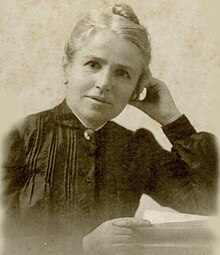Marie Rennotte | |
|---|---|
 Rennotte ca. 1900–1910 | |
| Born | Jeanne Françoise Joséphine Marie Rennotte 11 February 1852 Souverain-Wandre near Liège, Belgium |
| Died | 21 November 1942 (aged 90) São Paulo, Brazil |
| Nationality | Belgian Brazilian |
| Other names | Marie Renotte |
| Occupation(s) | Physician, teacher, women's rights activist |
| Years active | 1875–1935 |
Marie Rennotte (11 February 1852 – 21 November 1942) was a Belgian-born Brazilian physician, teacher, and women's rights activist. She was active in the fight for women's rights. After earning her teaching credentials in Belgium and France, Rennotte taught for three years in Germany before moving to Brazil as a governess. Giving private lessons and teaching at a girls' school, she lived in Rio de Janeiro from 1878 to 1882. Hired to teach in the State of São Paulo, she moved to Piracicaba where from 1882 to 1889 she taught science, developed the curriculum, and enhanced the reputation of the Colégio Piracicabano. The co-educational school was an innovative institution offering equal education to girls and boys.
In 1889, on a scholarship provided by the State of São Paulo, Rennotte enrolled in medical school at the Woman's Medical College of Pennsylvania in Philadelphia. That year, she was granted citizenship when a legal change allowed all foreigners permanently living in Brazil to become naturalized. Graduating in 1892, she studied at the Paris Hôtel-Dieu Hospital between 1893 and 1895, completing a specialization in obstetrics and gynaecology. Upon her return to Brazil, she defended her thesis to a jury from the Faculty of Medicine and Pharmacy of the University of Rio de Janeiro, validating her degree and allowing her to practice medicine in the country. From 1895 to 1899, Rennotte directed the obstetrics and maternity unit of the Maternity Hospital of São Paulo. She attended patients in the hospital as well as in private homes where she helped to deliver babies. Opening her own practice after she resigned from the Maternity Hospital, she operated a dispensary for the poor and immigrant communities, while continuing to see paying patients.
In 1901, she was admitted as a member of the São Paulo branch of the Brazilian Historic and Geographic Institute. She conducted research at the surgery of the Santa Casa da Misericórdia on the effects of chloroform as an anesthetic from 1906 to 1910. Then she traveled to Europe to study how to establish a Red Cross Branch in São Paulo. Upon her return she founded the local branch in 1912, opened a nurses training school, and began a campaign to found the first children's hospital in São Paulo. She continued to practice medicine through the mid-1920s, but increasingly in the late 1920s and the 1930s became more involved in the international feminist movement and scientific conferences. In 1922, she founded the Aliança Paulista pelo Sufrágio Feminino (Paulistan Alliance for Women's Suffrage). By the late 1930s, suffering from ill health, blindness and deafness, she was granted a state pension, which she collected until her death in 1942. She is remembered for her work to improve women's educational and health care options, and women's rights to employment and citizenship.[1] She is also recognized as one of those who defined feminist thought in Brazil during the 19th century.[2]
- ^ Mott 2005, pp. 66–67.
- ^ De Luca & Assis De Luca 2003, p. 707.